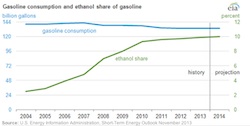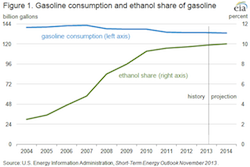 Iowa Governor Terry Branstad, Lt. Gov. Kim Reynolds, Senator Chuck Grassley, Representative Steve King, and Iowa Secretary of Agriculture Bill Northey joined the Iowa RFS Coalition and more than 300 Iowans to urge the Obama Administration and the Environmental Protection Agency (EPA) to restore strong blending levels for 2014 under the federal Renewable Fuel Standard (RFS). The “Defend the RFS” event was held at Lincolnway Energy near Nevada, Iowa exactly one week after the EPA unveiled a proposal that would gut the RFS and jeopardize rural economies.
Iowa Governor Terry Branstad, Lt. Gov. Kim Reynolds, Senator Chuck Grassley, Representative Steve King, and Iowa Secretary of Agriculture Bill Northey joined the Iowa RFS Coalition and more than 300 Iowans to urge the Obama Administration and the Environmental Protection Agency (EPA) to restore strong blending levels for 2014 under the federal Renewable Fuel Standard (RFS). The “Defend the RFS” event was held at Lincolnway Energy near Nevada, Iowa exactly one week after the EPA unveiled a proposal that would gut the RFS and jeopardize rural economies.
“The EPA proposal for 2014 guts the RFS which would lead to higher gasoline prices and lower farm income,” said Iowa Renewable Fuels Association (IRFA) Executive Director Monte Shaw. “The Obama Administration fell for Big Oil’s bluff, but there’s still time to defend the RFS. All Iowans need to step up and let the EPA know this proposal cannot stand. The Obama Administration should not turn its back on Iowa farmers and rural America.”
Iowans were urged to defend the RFS and protect the rural economy by sending an official comment to the EPA. In addition to creating an extra-legal waiver mechanism, the EPA proposal lowers the “corn ethanol” level from 13.8 billion gallons in 2013 to only 13 billion gallons in 2014. The proposal also freezes the biodiesel level at 1.28 billion gallons despite the fact the biodiesel industry is currently operating at an annualized rate of 2 billion gallons.
Lincolnway Energy CEO Eric Hakmiller kicked off the event by noting, “Every member of the Iowa Congressional delegation wanted to be here. While scheduling conflicts prevented some from attending in person, they are all here in spirit. When the EPA unveiled the RFS proposal one week ago, the Iowa Congressional delegation spoke with one voice, regardless of party, and said, ‘this must not stand!’”
Iowa is the largest biofuels producer in the country with 42 ethanol refineries capable of producing over 3.8 billion gallons annually, with three cellulosic ethanol facilities currently under construction. In addition, Iowa has 12 biodiesel facilities with the capacity to produce nearly 315 million gallons annually. A fall of the biodiesel industry would be catastrophic for the state’s economy and rural companies.
 Iowa Governor Terry Branstad told the crowd, “As the leading agriculture state in the nation, we know how important agriculture and renewable fuels are to the economic vitality and future in Iowa. We want good jobs in our state, and we want agribusiness and our communities to thrive. We need to reduce our dependence on foreign oil and we need to continue to provide American-made renewable fuels to consumers. We all need to stand together in opposition to this EPA proposal. We cannot forget that over 44,000 jobs are in jeopardy based on one proposal by the EPA, and we must work together to protect these jobs.”
Iowa Governor Terry Branstad told the crowd, “As the leading agriculture state in the nation, we know how important agriculture and renewable fuels are to the economic vitality and future in Iowa. We want good jobs in our state, and we want agribusiness and our communities to thrive. We need to reduce our dependence on foreign oil and we need to continue to provide American-made renewable fuels to consumers. We all need to stand together in opposition to this EPA proposal. We cannot forget that over 44,000 jobs are in jeopardy based on one proposal by the EPA, and we must work together to protect these jobs.”
“The federal government made a commitment to renewable energy, and the EPA is undermining the commitment,” said Senator Chuck Grassley. All of us who support homegrown, clean-burning energy and forward-thinking energy policy need to speak out and let the Administration know that its proposal is short-sighted and irresponsible.”
Representative Steve King said in his remarks, “The RFS is the only tool that provides market access so that ethanol and other renewable fuels can be sold in competition with petroleum. It is disappointing the EPA has decided to lower RFS numbers and make the United States more dependent on foreign sources of energy when we have the means to produce cleaner, greener fuels right here in America.”
Iowa Secretary of Agriculture Bill Northey reminded the crowd, “Ethanol and biodiesel have been tremendous success stories that have benefited consumers, farmers, the economy and the environment and it is unfortunate the EPA is trying to undermine this important industry. It is vital we stand up for these home-grown fuels and share our opposition to this proposal with the Administration.”Read More
 Researchers at the U.S. Department of Agriculture (USDA) have found a way to turn a by-product of ethanol production into a biodegradable form of kitty litter. This news release from the Agricultural Research Service (ARS) says USDA plant physiologist Steven Vaughn and his colleagues are using dried distiller’s grains, DDGs, as a starting material for a more environmentally friendly alternative to nonbiodegradable clay-based litters.
Researchers at the U.S. Department of Agriculture (USDA) have found a way to turn a by-product of ethanol production into a biodegradable form of kitty litter. This news release from the Agricultural Research Service (ARS) says USDA plant physiologist Steven Vaughn and his colleagues are using dried distiller’s grains, DDGs, as a starting material for a more environmentally friendly alternative to nonbiodegradable clay-based litters. 












